Harissa is a North African red chile paste or sauce made of a few simple ingredients including chiles, garlic, olive oil, citrus and a few warm spices.
This versatile harissa recipe is slightly sweet, smoky, tangy, and just enough spicy but not too hot. Make it ahead and use in many ways! Be sure to watch the video below.
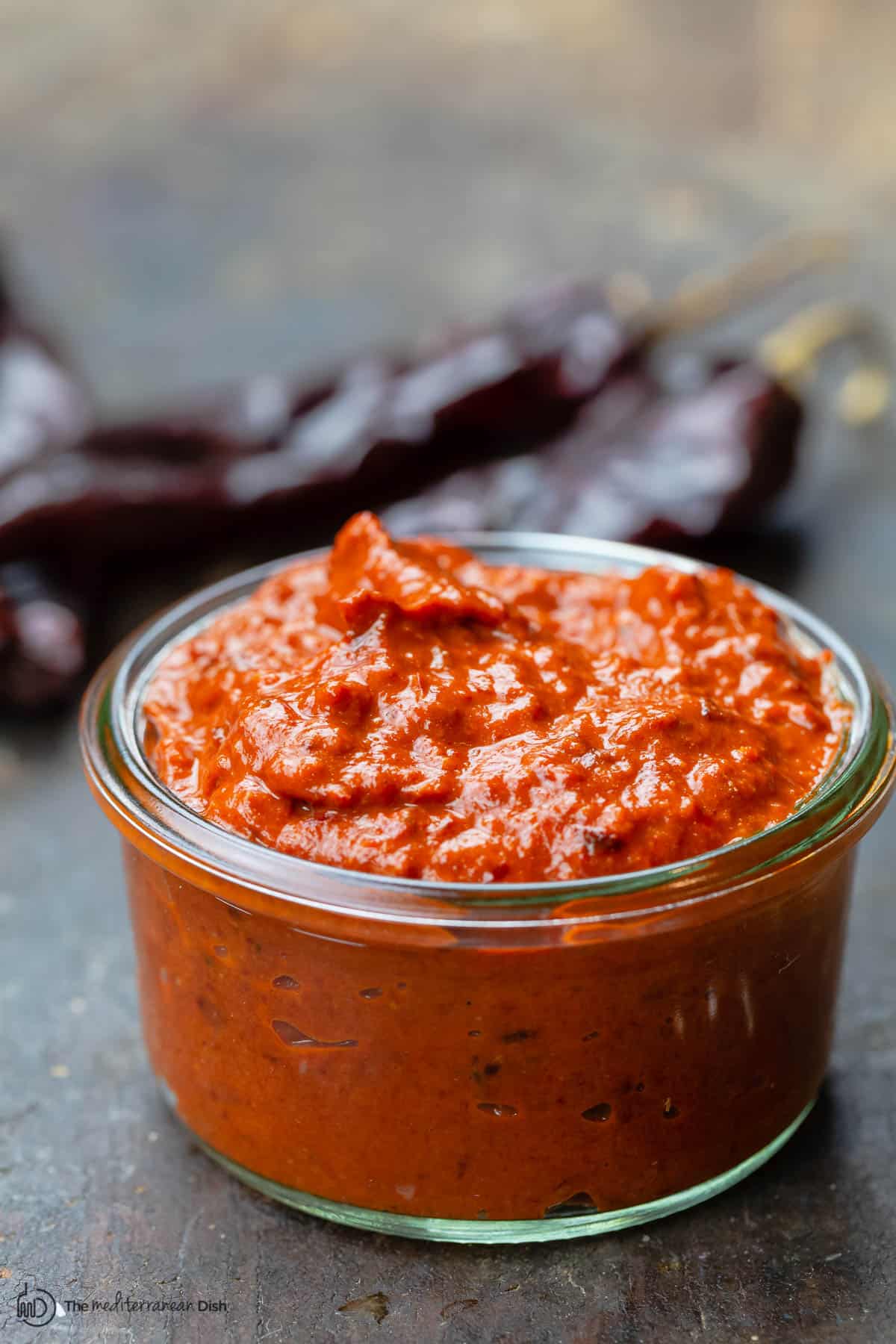
You’ve seen me use harissa spice blend in different recipes, but today we’re going to chat about harissa sauce! This, along with my earlier toum garlic sauce, belong under versatile Mediterranean dips and condiments you’ll find yourself using over and over again!
What is harissa?
I’ve heard people describe harissa as the ketchup or sriracha of North Africa and the Middle East.
It may be a red condiment that is as popular as ketchup because of the many way it is used and enjoyed. But comparing the two does not do harissa justice. Harissa is much more complex in flavor and all together addictive!
Originally from Tunisia, harissa is a chile sauce or paste typically made of dry red chiles, garlic, citrus, extra virgin olive oil and a few warm spices including cumin, coriander and caraway seeds.
And although you can find it at specialty grocery stores sold in jars or tins, homemade harissa is a completely different experience.
What does it taste like? This harissa sauce recipe is mild with just enough kick, sweet, smoky, and a little bit tangy. Absolutely addictive!
Making harissa at home is easier than most people think; be sure to watch the video below.
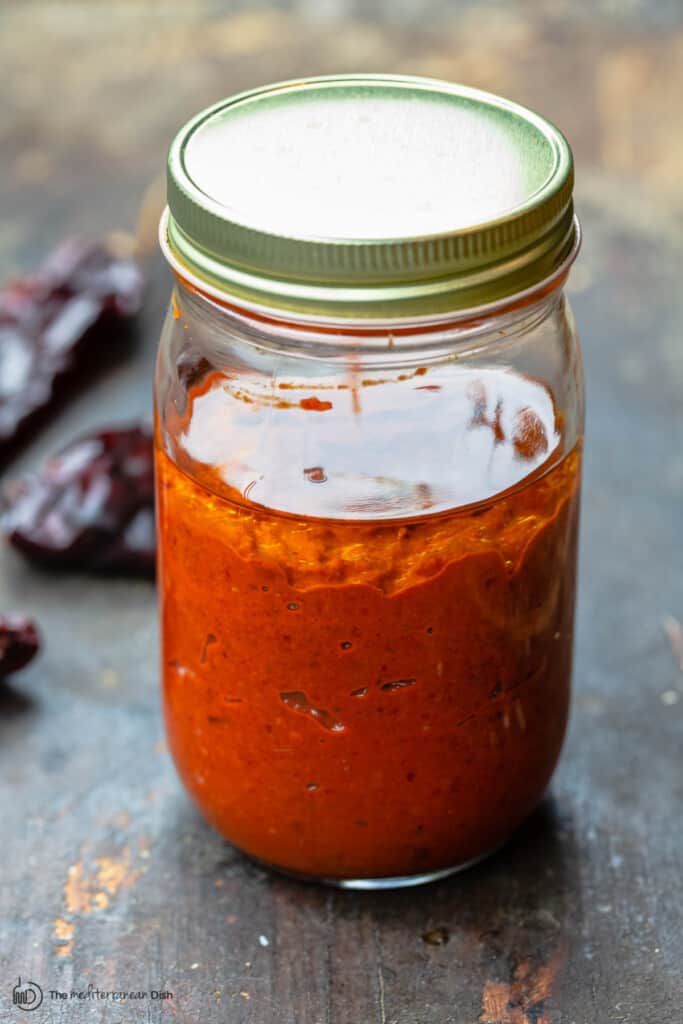
What kind of chiles to use for harissa?
Each batch of homemade harissa sauce may taste slightly different than the other, depending on the kind of chiles used. And as a result, some can be fairly hot, while others are mild.
You can pretty much make harissa out of any dried red chile according to your own personal heat index.
Because I like to control the heat factor in my harissa paste, I like the idea of using New Mexico chiles, which are milder but offer enough of a kick (Cookbook author Paula Wolfert believes that Gujaillo and New Mexico chiles are closest to the peppers of Nabeul and Gabès in Tunisia).
You can absolutely use a combination of chile peppers. Need more heat? Add a couple of de arbol peppers. If you like a bit of smokiness, add chipotle chile.
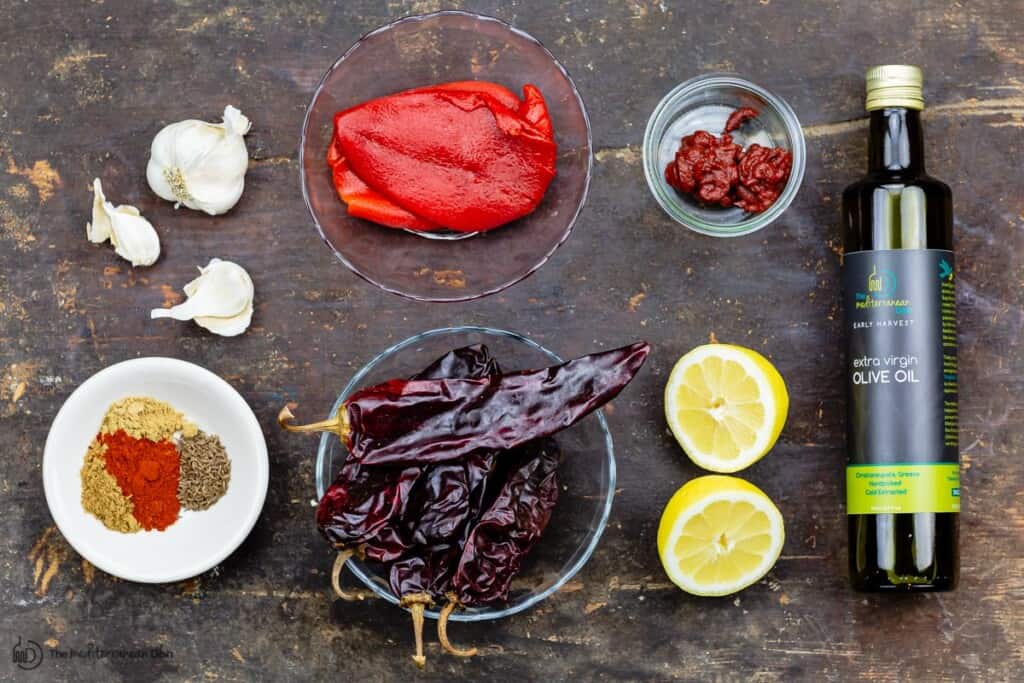
What you need to make it:
When I tested my harissa paste recipe, it was important for me to find the perfect balance of spicy, sweet, smoky, and tangy all in one red chile paste, and the following ingredients did just that:
- Dry red chiles (7 whole chiles). I prefer New Mexico chiles or Guajillo chiles which are milder (this allows me to add more heat as needed).
- Roasted red peppers (6 ounces or 2 large roasted red peppers). Jarred peppers will work here, just drain them well. These will add sweetness and also support the texture of the harissa paste.
- Tomato paste (2 tablespoons or so) for the umami factor.
- Fresh garlic cloves. I usually use 4 cloves, but if you enjoy more garlic, go for it!
- Spices. A combination of North African flavors from 2 teaspoons each coriander and cumin; 1 teaspoon caraway seeds toasted and ground (use a mortar and pestle, grinder, or food processor); 1 teaspoon smoked paprika (this adds depth and smokiness without adding more spice). I also use a pinch of cayenne pepper; start with 1/2 teaspoon and go from there.
- Kosher salt
- Citrus. Juice of 1 large lemon (do not skip this as it adds brightness and rounds out flavor).
- Extra virgin olive oil. This is drizzled into the food processor as the rest of the ingredients are mixing together. Use a quality EVOO that you enjoy; I used Early Harvest Greek EVOO.
How to make harissa
Making harissa at home could not be simpler!
First, you’ll soak the dry red chiles (whatever combination of chile peppers you selected) in hot water to rehydrate. If you don’t rehydrate them, you can’t exactly turn them into paste.
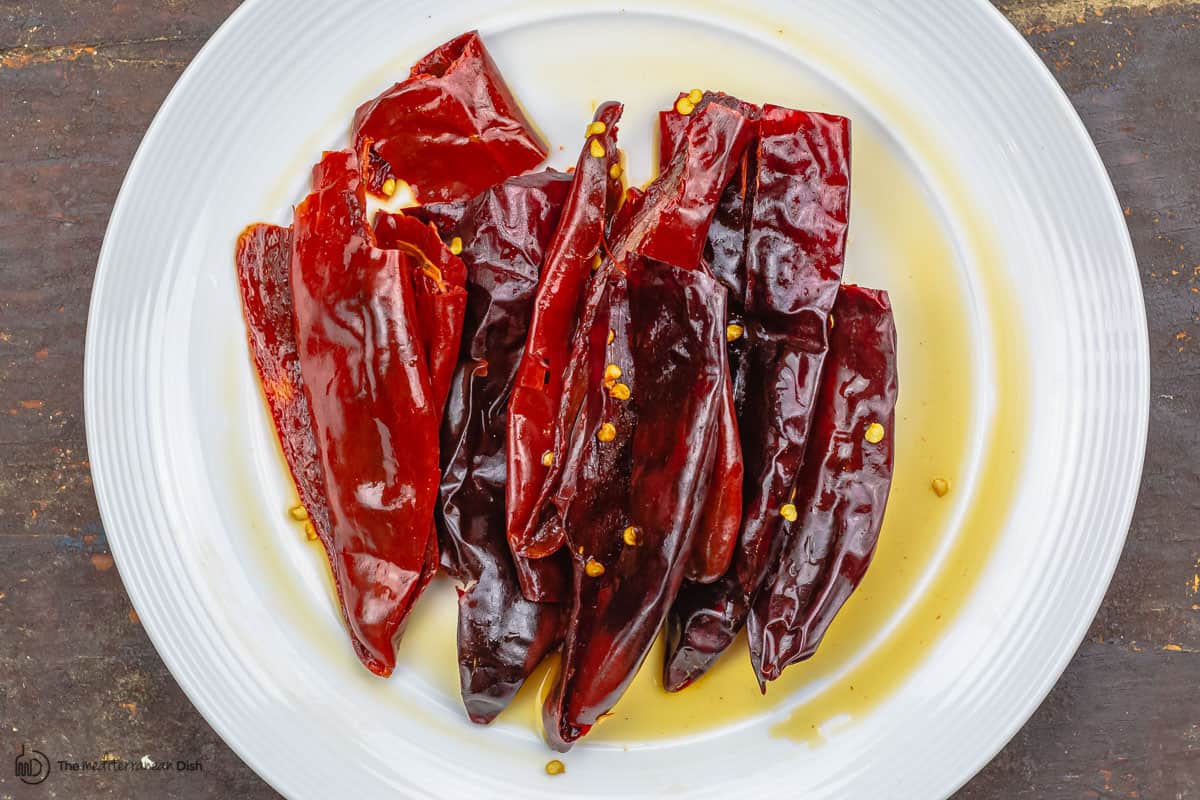
From there, seed the chiles and blend them in a food processor with the roasted red peppers, garlic, tomato paste, spices, and lemon juice.
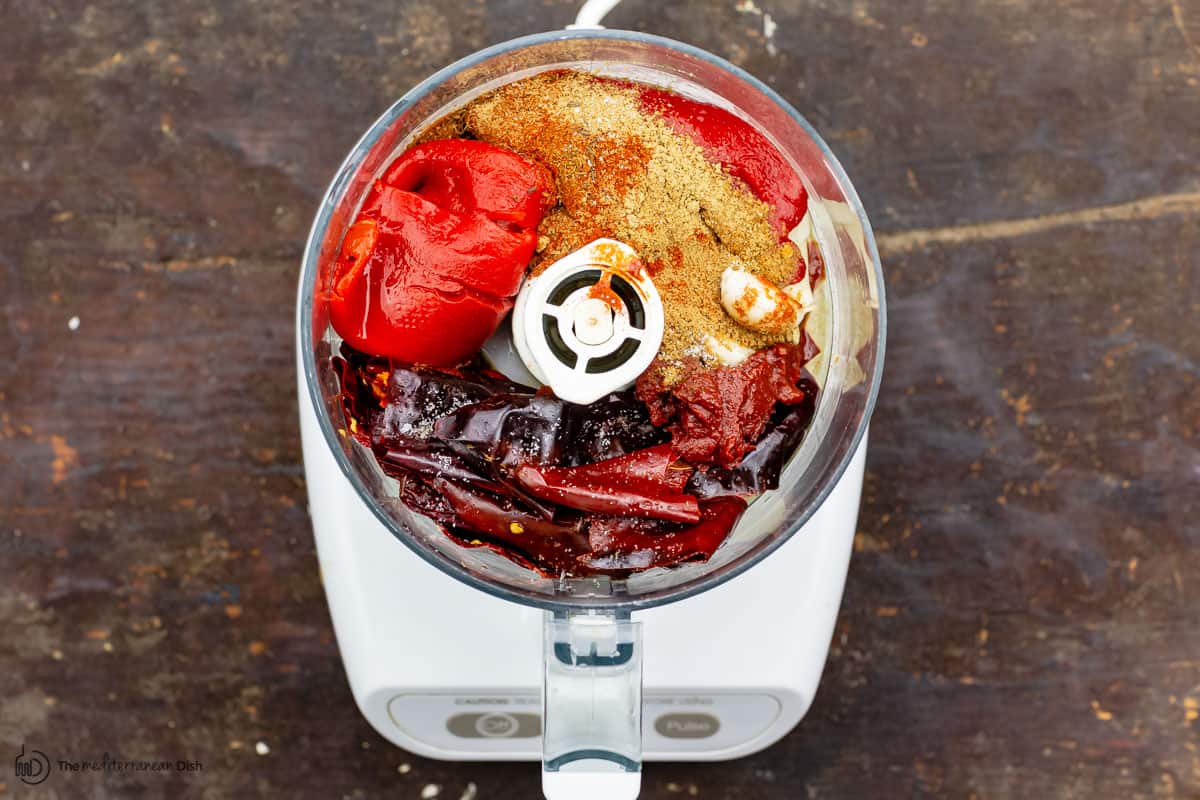
Drizzle the extra virgin olive oil as the ingredients are mixing until you arrive at a beautiful, slightly chunky paste. That’s it!
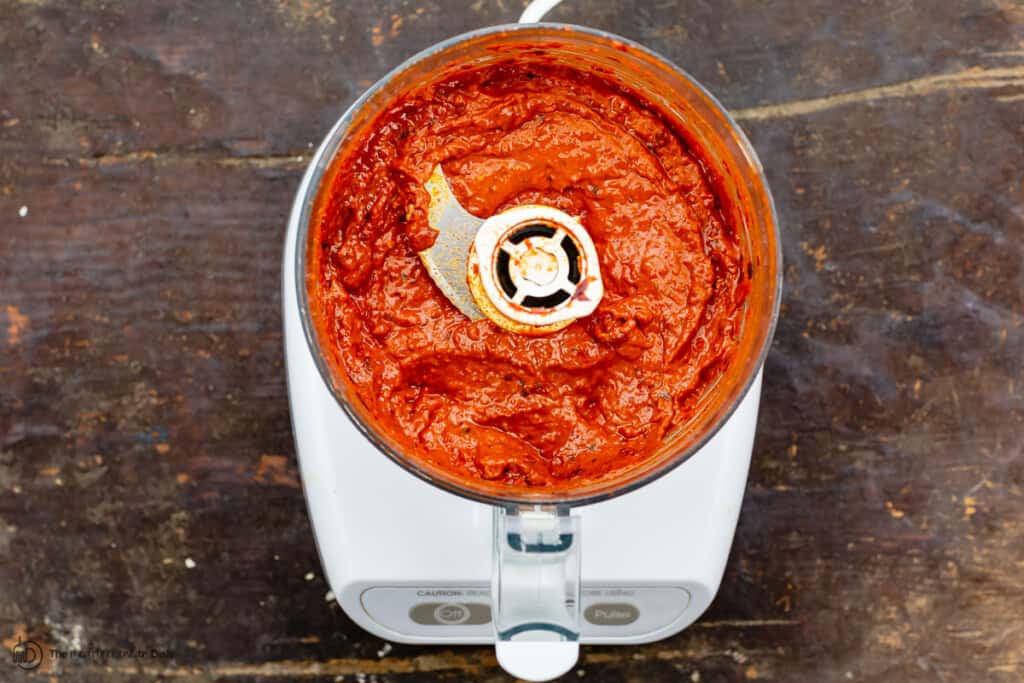
It’s even better the next day!
You can use harissa sauce as soon as you make it, but if you refrigerate it and use it the next day or two, the flavors will meld well and create a much deeper chile paste you’ll love!
Storage
I like to store my homemade harissa in the fridge in a tight lid mason jar. Adding a drizzle of extra virgin olive oil on top will help seal it well. It typically lasts 2 to 3 weeks in the fridge.
You can also freeze it for later use (about a month or so).
Ways to use harissa
Once you make harissa paste at home, you’ll find yourself using it in many different ways. Here are a few ideas:
- One of my favorite ways to use it is in this harissa chicken recipe. But it’s also great to season fish, fish kofta, or vegetables for grilling or baking. I also love the heat it brings to my Chicken Kofta Kebabs with Garlic-Mint Yogurt.
- Add a couple tablespoons of your homemade harissa to a soup like this red lentil soup or Moroccan vegetable stew or lamb stew. Or add some to your shakshuka for a little kick!
- Stir it in your hummus to add a kick or as a topping to your chicken kofta or lamb burger in place of Tzatziki.
- Use on scrambled eggs just like hot sauce, or whisk it into your Tunisian-style frittata.
Browse all recipes here. Join my free e-mail list
Easy Harissa Recipe
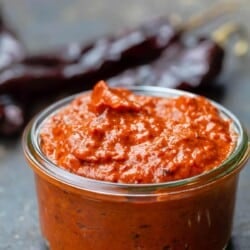
Equipment
Ingredients
- 7 Dried New Mexico Chiles or Guajillo Chiles, or a combination of dried New Mexico Chiles and another kind of dried hot chiles such as de arbol or chipotle chiles
- 6 oz jarred roasted red peppers, drained rinsed, and dried (2 large peppers)
- 2 tbsp tomato paste
- 4 large garlic cloves, peeled
- 1 tsp caraway seeds, toasted and ground (use a mortar and pestle, grinder or food processor)
- 2 tsp ground coriander
- 2 tsp ground cumin
- 1 tsp smoked paprika
- ½ tsp cayenne pepper
- Kosher salt
- Juice of 1 large lemon, 2 tbsp fresh lemon juice
- 2 tbsp quality extra virgin olive oil, more for later
Instructions
- Soak and prepare the dried chiles. Place the dried chiles in a heat-safe bowl and cover with hot water. Set aside for 30 minutes until the chiles are tender and re-hydrated. Drain the chiles and remove the stems and seeds.
- Combine chiles with the remaining ingredients. Transfer the chiles to the bowl of a large food processor fitted with a blade. Add the tomato paste, roasted red peppers, garlic, ground caraway seeds, coriander, cumin, smoked paprika, cayenne (if using), and a large pinch of kosher salt. Add fresh lemon juice.
- Make the harissa paste. Run the food processor, and while it’s running, drizzle the extra virgin olive oil from the top opening. Stop the processor to scrape down the sides and run again until you reach the desired paste-like texture. Taste and adjust seasonings to your liking (remember that harissa paste will deepen in flavor as it sits in the fridge over the next day or two).
- Store. Transfer the harissa paste to a clean mason jar. Cover with a very thin layer of extra virgin olive oil, then cover the jar with its lid tightly and refrigerate.
Video
Notes
- This recipe makes about 1 1/2 cups of harissa paste. A serving size is 2 tablespoons.
- Cook’s Tip: You can use this homemade harissa paste as soon as you make it, but for best flavor allow it at least 1 to 2 days in the fridge.
- Storage: Homemade harissa can last in the fridge for 2 to 3 weeks, properly stored in a covered mason jar and the top the harissa paste covered with a thin layer of extra virgin olive oil. You can use a little bit of the harissa paste at a time, but be sure to add a bit more extra virgin olive oil to cover the top before storing in the fridge again.
- Can you freeze it? Yes! You can freeze harissa paste for up to 1 month or so. Best to freeze individual smaller portions.
- Visit Our Shop to browse quality Mediterranean ingredients, including spices and extra virgin olive oil used in this recipe.

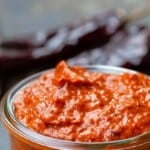
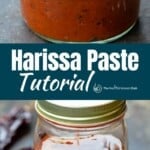
Instead of dried chilli, can I use fresh birds eye little chilli. Very hot.
Hi, Marer. I have seen some Harissa recipes using birds eye chillies, so it may work, but I have not personally tested it with this recipe.
We don’t have the Mexican chillies in Australia and doubt Moroccans use those either. What can be used in place? Thanks
Moroccans might use Baklouti peppers, which have been bred in the region for generations. But hot peppers and tomatoes are both native to Mesoamerica, and would have been brought to North Africa by the Portuguese and Spanish during the time the Americas were colonized. So it wouldn’t be THAT “inauthentic” to use Mexican peppers, as they’re the ancestors of the Baklouti peppers.
Looks like a great recipe. Have you tried canning your Harissa?
Can I can jars of my home made Harissa?
Any thoughts on how would canning impact flavor?
Looking forward to trying this.
I have not, but if you give it a try, I’d love to hear any tips you have! Canning is not something I’m super familiar with.
I’ve never cared for jarred harissa, so I was thrilled to find your recipe. I started the process and realized I didn’t have caraway seeds (or any substitutes), so I made it without and may add it tomorrow, or not…it tastes amazing even without it. I may also add a couple of hotter chiles next time because I like the heat.
I want to use this as a marinade for whole roasted chicken…any thoughts? Seriously, everything I’ve made from your site is delicious.
Thanks, Melissa! I do think this would be great for a whole-roasted chicken! You could refer to my Grilled Harissa Chicken recipe for some other great spices to use in a harissa rub/marinade.
It turned out great and chicken was juicy in the dutch oven. I also went back and added the caraway seeds as well as some de arbol chiles with the seeds for heat. It’s absolutely perfect for me 🙂
Yay! Thanks for sharing, Melissa!
Great information and details. Love the pictures of ingredients, thanks
Hi, thanks for share, I live in Kuwait I cannot find Guajillo Chiles neither Ancho or mild chiles =( where I can order or find them? thanks
I have been absent for a while, but now I remember why I used to love this web site. Thank you, I will try and check back more often. How frequently you update your web site?
Hello! I update or add new recipes 3-4x/ week at the moment. You can join our email list here to stay up to date on everything :).
I want the flavour of harissa but can’t take too much heat. Could I use ancho chilis? They are about 1,300 in the Scoville scale and guajillo has a heat ranging from 2,500 to 5,000 on the Scoville scale. Or would it then not be harissa? I love your recipes and having a ball trying so many of them out. Thank you!
Hi, Trish, I have seen recipes for Harissa using ancho chili’s, but it’s not something I’ve tested myself. If you give it a try, I’d love to hear how it went!
I plan to make your recipe for Harissa, but must first make the tomato paste. I could not find a link to the video, is it disabled, or missing?
Thanks,
RY
Hello! I use store-bought tomato paste here. I don’t have a recipe or video for it. There is a video for the Harissa Paste/Sauce at the bottom of the post. I just checked, and it’s functional on my end. Unfortunately, some browsers block pop ups which, for some reason, also blocks instructional videos. You may need to adjust your browser settings, or try a different browser on your end.
I love this recipe, but live alone and am wondering how well it freezes since I won’t go through the whole batch within 2-3 weeks.
Hello! You can freeze harissa paste for up to 1 month or so. Best to freeze individual smaller portions.
Grew so many chillies this year,gave this a go. Used fresh chillies(5) and no cayenne. Love it! Living in Greece we eat lots of things to go with this. Thank you!
So glad the recipe worked for you! Thanks, Lesley!
Amazing
Before I found your recipe for the harrisa I would buy from the store, not any more this recipe is amazing, I love it and followed your recipe on the video, I never leave reviews but for this harrisa. I had to, top marks thanks.
So glad you enjoyed it, Graham!
I am leaving a 5 star rating for you recipe, even though I haven’t tried it yet. I bought a tagine years ago when I had the opportunity to visit Morocco, have only used it once. I have one Moroccan chicken tagine recipe which I have used a couple of times, minus some of the ingredients listed. Like harissa – I had no idea what it was until I got to your site 10 minutes ago. Now I know, and it looks like a simple thing to put together. I have printed out 3 copies so that I can share the recipe. I have subscribed to your email list, I am so looking forward to trying more of your recipes to learning to make more Mediterranean recipes and enjoy healthier meals. Thank you, thank you, thank you!
Welcome to The Mediterranean Dish, Marcia! Hope you end up loving this recipe!!
Delicious, a Mediterranean restaurant I like had harissa, I’m very happy to be able to recreate it. It is so perfect with Greek salad.
This is such a great recipe, way better than the jar stuff I’ve bought at Trader Joes (which was not in stock, which lead me to this recipe, so a sideways thanks, TJ’s!) How good? I went looking for other recipes to put this in. Thank you so much!
Forgot to add the big reason I wanted to post, was that I used Aleppo Pepper instead of the paprika/cayenne pepper mix, one of the things that made me love it so much.
Glad you loved it, Peter!!